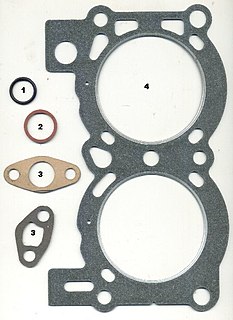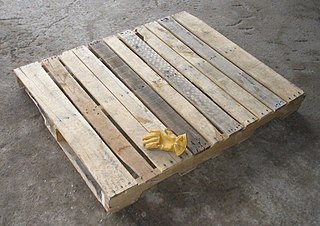
The Subaru Forester is a compact crossover SUV that's been manufactured since 1997 by Subaru. Available in Japan from 1997, the Forester shares its platform with the Impreza. It has been awarded Motor Trend's 2009 and 2014 SUV of the Year and The Car Connection's Best Car To Buy 2014.

An envelope is a common packaging item, usually made of thin, flat material. It is designed to contain a flat object, such as a letter or card.

Plywood is a material manufactured from thin layers or "plies" of wood veneer that are glued together with adjacent layers having their wood grain rotated up to 90 degrees to one another. It is an engineered wood from the family of manufactured boards which include medium-density fibreboard (MDF) and particle board (chipboard).

Drywall is a panel made of calcium sulfate dihydrate (gypsum), with or without additives, typically extruded between thick sheets of facer and backer paper, used in the construction of interior walls and ceilings. The plaster is mixed with fiber, plasticizer, foaming agent, and various additives that can reduce mildew, flammability, and water absorption.

A gasket is a mechanical seal which fills the space between two or more mating surfaces, generally to prevent leakage from or into the joined objects while under compression.

Cordwood construction is a term used for a natural building method in which short logs are piled crosswise to build a wall, using mortar or cob to permanently secure them. This technique can use local materials at minimal cost.

The Cesky Terrier is a small terrier type dog originating in Czechoslovakia.

A pallet is a flat transport structure, which supports goods in a stable fashion while being lifted by a forklift, a pallet jack, a front loader, a jacking device, or an erect crane. A pallet is the structural foundation of a unit load which allows handling and storage efficiencies. Goods or shipping containers are often placed on a pallet secured with strapping, stretch wrap or shrink wrap and shipped. Since its invention in the twentieth century, its use has dramatically supplanted older forms of crating like the wooden box and the wooden barrel, as it works well with modern packaging like corrugated boxes and intermodal containers commonly used for bulk shipping.
The shank is the end of a drill bit grasped by the chuck of a drill. The cutting edges of the drill bit contact the workpiece, and are connected via the shaft with the shank, which fits into the chuck. In many cases a general-purpose arrangement is used, such as a bit with cylindrical shaft and shank in a three-jaw chuck which grips a cylindrical shank tightly. Different shank and chuck combination can deliver improved performance, such as allowing higher torque, greater centering accuracy, or moving the bit, but not the chuck, with a hammer action.
Since the widespread adoption of reel-to-reel audio tape recording in the 1950s, audio tapes and tape cassettes have been available in many formats. This article describes the length, tape thickness and playing times of some of the most common ones.

In metalworking, rolling is a metal forming process in which metal stock is passed through one or more pairs of rolls to reduce the thickness and to make the thickness uniform. The concept is similar to the rolling of dough. Rolling is classified according to the temperature of the metal rolled. If the temperature of the metal is above its recrystallization temperature, then the process is known as hot rolling. If the temperature of the metal is below its recrystallization temperature, the process is known as cold rolling. In terms of usage, hot rolling processes more tonnage than any other manufacturing process, and cold rolling processes the most tonnage out of all cold working processes. Roll stands holding pairs of rolls are grouped together into rolling mills that can quickly process metal, typically steel, into products such as structural steel, bar stock, and rails. Most steel mills have rolling mill divisions that convert the semi-finished casting products into finished products.
Automobile tires are described by an alphanumeric tire code or tyre code, which is generally molded into the sidewall of the tire. This code specifies the dimensions of the tire, and some of its key limitations, such as load-bearing ability, and maximum speed. Sometimes the inner sidewall contains information not included on the outer sidewall, and vice versa.

The Mini Lop is a breed of domestic rabbit that is recognized by the American Rabbit Breeders Association (ARBA). It is different from the Miniature Lop breed that is recognized by the British Rabbit Council (BRC). The Mini Lop [US] and the Miniature Lop [UK] are different from the Dwarf Lop breed that is recognized by the BRC. The Mini Lop is similar to several other small rabbit breeds, such as the Dwarf rabbit.
The Flat Display Mounting Interface (FDMI), also known as VESA Mounting Interface Standard (MIS) or colloquially as VESA mount, is a family of standards defined by the Video Electronics Standards Association for mounting flat panel monitors, televisions, and other displays to stands or wall mounts. It is implemented on most modern flat-panel monitors and televisions.

A plasterer is a tradesman who works with plaster, such as forming a layer of plaster on an interior wall or plaster decorative moldings on ceilings or walls. The process of creating plasterwork, called plastering, has been used in building construction for centuries.
Thick-film dielectric electroluminescent (TDEL) technology is a phosphor-based flat panel display technology developed by Canadian company iFire Technology Corp. TDEL is based on inorganic electroluminescent (IEL) technology and has a novel structure that combines both thick- and thin-film processes. An IEL device generates light by applying an alternating electrical field to inorganic light-emitting phosphors. Traditional IEL displays are bright, very fast in video response time and highly tolerant of environmental extremes. However, the lack of full-color capability and large-size scalability has limited their application for the mainstream consumer television market. iFire has addressed these limitations by replacing the thin-film dielectric of traditional IEL technology with its patented thick-film, high-K dielectric material and structure. The result is a unique flat panel display technology that provides iFire displays with high performance and low cost potential. iFire was unable to develop displays competitive with LCD, plasma and OLED devices and wound up research and development in 2007.
Dimensional weight, also known as volumetric weight, is a pricing technique for commercial freight transport, which uses an estimated weight that is calculated from the length, width and height of a package.

A compressed earth block (CEB), also known as a pressed earth block or a compressed soil block, is a building material made primarily from damp soil compressed at high pressure to form blocks. Compressed earth blocks use a mechanical press to form blocks out of an appropriate mix of fairly dry inorganic subsoil, non-expansive clay and aggregate. If the blocks are stabilized with a chemical binder such as Portland cement they are called compressed stabilized earth block (CSEB) or stabilized earth block (SEB). Typically, around 3,000 psi (21 MPa) is applied in compression, and the original soil volume is reduced by about half.
STD-4C or STANDARD-4C refers to a set of standards and regulations set by the United States Postal Service regarding the specifications of cluster mailbox units used in new construction. All multi unit constructions building plans submitted after October 6, 2006 are required to use STD-4C compliant mailboxes
Cardboard is a generic term for heavy-duty paper-based products having greater thickness and superior durability or other specific mechanical attributes to paper; such as foldability, rigidity and impact resistance. The construction can range from a thick sheet known as paperboard to corrugated fiberboard which is made of multiple corrugated and flat layers.












